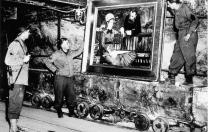Harvard men struggling to protect artistic and historical treasures in World War II included:
Mason Hammond ’25, Litt.D. ’94
In 1943, Hammond—later Pope professor of the Latin language and literature and unofficial Harvard historian—was appointed the first adviser on Fine Arts and Monuments to the U.S. Army. He served in North Africa, Italy, England, and Germany.
Walter J. Huchthausen, M.Arch. ’30
Huchthausen, an architect and professor at the University of Minnesota before the war, was attached to the Ninth Army. Stationed mainly in Aachen and responsible for much of northwest Germany, he was killed during a mission in April 1945.
Lincoln Kirstein ’30
Kirstein had founded the School of American Ballet before the war and would found the New York City Ballet Company after it. He joined the army as a private at the age of 36 and eventually gained assignment to the Third Army’s Monuments unit.
Charles L. Kuhn, Ph.D. ’29
As director of the Busch-Reisinger Museum, Kuhn sought even before the war to acquire and preserve works of modern art the Nazis deemed “degenerate.” He spent most of his Monuments service pursuing stolen and lost art in Germany and Austria.
James J. Rorimer ’27
Rorimer, who’d helped create The Cloisters to house the Metropolitan Museum of Art’s medieval collections, was attached to the Seventh Army; he helped discover some of the greatest Nazi repositories, including those at Neuschwanstein and the Heilbronn mines. He would become director of the Metropolitan Museum in 1955.
Paul Sachs ’00, Ar.D. ’42
As director of the Fogg Art Museum and a member of the Roberts Commission, Sachs recruited many of his former students to serve as Monuments Men.
George Stout, A.M. ’29
One of the first Monuments Men, Stout served with the Twelfth Army Group.
Langdon Warner ’03
Curator of Oriental art at the Fogg Museum, Warner was an expert consultant to the military and is credited with saving the cities of Kyoto and Nara from bombing.
Otto Wittmann Jr. ’33
Wittmann, later director of the Toledo Museum of Art, served with the Office of Strategic Services and investigated Nazi art thefts, particularly from French Jews.
To learn more, or share data about the Monuments Men, go to www.monumentsmenfoundation.org.








